

| Home | Log In | Register | Our Services | My Account | Contact | Help |
You are NOT currently logged in
dai oldenrich - 01 Sep 2006 13:32
click your browser refresh button to update charts
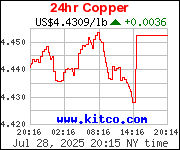
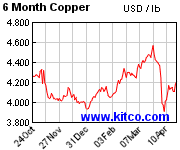
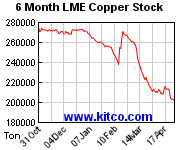
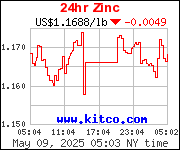
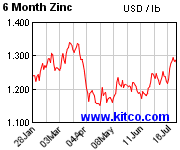
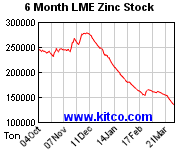
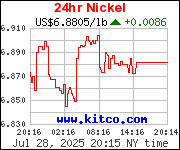
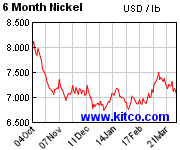
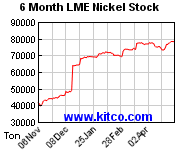
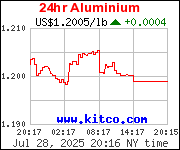
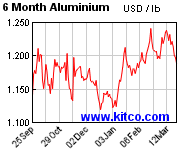
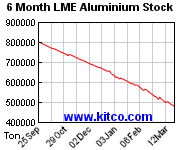
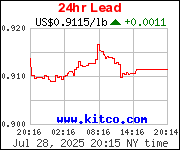
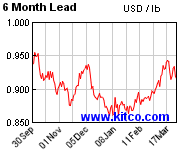
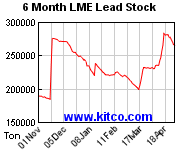
Also see: gold charts here silver charts here platinum charts here
dai oldenrich - 25 Oct 2006 07:14 - 140 of 181
FT.com - By Chris Flood
Dealers said base metals trading was lacklustre, suffering from weak volumes amid a reluctance to open new positions ahead of the Federal Reserve meeting on US interest rates. Trading is expected to remain quiet this week before the release of US third quarter GDP data on Friday.
Copper eased 0.8 per cent to $7,485 a tonne. Inco, the Canadian miner, said copper production in the third quarter was 27,668 tonnes, flat compared to the same period last year and lower than expected, mainly due to strike action at Voiseys Bay mine.
Codelco has begun wage negotiations early with union leaders from its largest division Codelco Norte which produced almost 1m tonnes of copper last year, alomost half of the Chilean state companys output.
Nickel retreated 0.5 per cent to $32,250 a tonne after it hit a record $32,700 in the previous session.
Zinc edged 0.4 peer cent lower to $3,905 a tonne in spite of a further fall in of 2,525 tonnes in LME inventories, shrinking rapidly towards the psychological level of 100,000 tonnes from 117,375 tonnes currently.
dai oldenrich - 25 Oct 2006 07:16 - 141 of 181
Oct. 25 (Bloomberg)
Gold Falls in Asian Trade as Charts Indicate More Drops Likely - By Chia-Peck Wong
Gold fell in Asian trade as charts some traders use to predict prices indicate that more declines may be in store.
Speculators and traders are selling gold after the bullion failed to break past $600 an ounce twice this month. That level is a so-called resistance on charts where sell orders cluster.
``Gold's falling on technical reasons, $600 looks to be a top so in the short-term, gold's outlook isn't very good,'' Yang Qing, the chief gold trader at the Bank of China Ltd., said by phone from Beijing.
Gold for immediate delivery fell as much as $2.35, or 0.4 percent, to $584.10 an ounce and traded at $584.39 at 11:55 a.m. Singapore time.
Traders are awaiting the outcome of the two-day meeting of Federal Open Market Committee of the U.S. Federal Reserve that starts today. Any comment from the Fed saying inflation is still a concern would help gold prices, Bank of China's Yang said.
All 106 economists surveyed by Bloomberg expect the Fed to hold its target rate at 5.25 percent today. Minutes from the Fed's September meeting, released Oct. 11, showed the central bank saw a ``substantial risk'' inflation may not recede.
``The gold market is likely to remain range-bound ahead of the Fed meeting,'' Darren Heathcote, head of trading at Investec Australia, said by phone from Sydney.
Gold futures for December delivery fell 10 cents to $587.50 an ounce in after-hours trading on the Comex division of the New York Mercantile Exchange at 11:48 a.m. Singapore time.
dai oldenrich - 25 Oct 2006 07:17 - 142 of 181
Oct. 25 (Bloomberg)
Copper Futures in Shanghai Drop Amid Concerns Growth Will Slow - By Xiaowei Li
Copper futures in Shanghai fell for a third day amid concern that the rate of growth in the world's fourth-largest economy is slowing, curbing demand for the metal used to make pipes and wires.
China's economic growth may be less than 10 percent next year as government curbs on investment and liquidity take effect, the National Development and Reform Commission's Academy of Macroeconomic Research said in a report today. China's economic expansion slowed for the first time in a year to 10.4 percent in the third quarter, after reaching a decade-high of 11.3 percent in the second quarter.
``The newly formed consensus on a slowing economy in 2007 is weighing on copper,'' Li Xun, a trader at Shanghai Continent Futures Co., said today. ``Investment funds are taking a more cautious approach, and have either suspended buying or switched to taking short positions.''
So-called short positions are bets that prices will fall.
Copper for delivery in December on the Shanghai Futures Exchange declined as much as 520 yuan, or 0.7 percent, to 70,280 yuan ($8,927) a metric ton. The contract traded at 70,500 yuan at the market's midday break.
Some investors were also reluctant to buy copper ahead of today's policy statement from the Federal Open Market Committee, which sets interest rates at the U.S. central bank, Li said.
While interest rate are expected to remain unchanged at 5.25 percent, the accompanying statement, due at about 2:15 p.m. Washington time, will give the bank's outlook on growth and inflation in the world's largest economy.
Copper for delivery in three months on the London Metal Exchange gained $25, or 0.3 percent, to $7,520 a ton at 11:29 a.m. Shanghai time. The contract yesterday fell $50, or 0.7 percent, to $7,495.
dai oldenrich - 27 Oct 2006 07:37 - 143 of 181
Oct. 27 (Bloomberg)
Gold Falls in Asia as Dollar Gains, Reducing Investment Appeal - By Feiwen Rong
Gold declined in Asia for the first session in four as the dollar strengthened against yen, diminishing the metal's appeal as an alternative investment.
The dollar rose as much as 0.3 percent against the yen on deflation concern in Japan and speculation the U.S. Federal Reserve will keep borrowing costs at a 5 1/2-year high for the rest of the year.
``The dollar is quite stable at the moment and that's bearish for the gold,'' Ellison Chu, manager of precious metals at Standard Bank Asia Ltd. said by phone from Hong Kong today.
Gold for immediate delivery declined as much as $2.5, or 0.4 percent, to $594.65 an ounce and traded at $595.98 at 13:11 a.m. Singapore time.
A stronger dollar makes gold less appealing versus other dollar-denominated assets such as stocks and bonds.
Still, gold may rebound because the Federal Reserve officials' latest comments on U.S. economy and interest rates ``will cause some weakness'' in dollar, said Rowan Menzies, chief commodity analyst at Commodity Warrants Australia in Sydney.
The interest rate differential between the U.S. and the euro-zone is likely ``to narrow further,'' Menzies said.
Crude Oil
Bullion also suffered today due to the prospect of bearish crude oil prices, said Mao Jian, gold trader with Bank of China in Beijing. Gold usually becomes a less appealing hedge against inflation when oil prices drop.
Crude oil for December delivery dropped as much as 16 cents, or 0.3 percent, to $60.20 a barrel in after-hours electronic trading on the New York Mercantile Exchange. Oil has fallen partly on signs pre-winter stockpiles in the U.S., the world's biggest oil consumer, are sufficient.
Gold for delivery in December declined as much as $2.80, or 0.5 percent, to $597 an ounce in after-hours electronic trade on the Comex division of the New York Mercantile Exchange. The contract traded at $598.60 at 12:53 a.m. Singapore time. The precious metal reached a 26-year high of $730.40 on May 12 as oil prices climbed to a record.
dai oldenrich - 27 Oct 2006 07:39 - 144 of 181
Metals Place - 26 October 2006
China's imported iron ore prices drop by 7.2 percent
China's imported iron ore prices dropped by 7.2 percent year-on-year to reach 62.7 U.S. dollars per ton on average in the first three quarters, statistics with the China Iron and Steel Association (CISA) show.
Analysts attributed the decrease to the slowdown of China's imports of iron ore.
China imported 247 million tons of iron ore in the first nine months, up a hefty 24.2 percent from a year earlier, but down 7 percentage points in growth rate, and meanwhile, this is the first time since 2003 that the import growth has dipped under the 30 percent bar, said Luo Bingsheng, CISA's vice chairman.
"The prices are declining because the imports of iron ore are turning to a moderate growth from a fast growth, which were influenced by the steady growth of domestic iron ore output," he told an ongoing international symposium on the iron raw material in Qingdao, east China's Shandong Province.
In the first three quarters, China produced more than 400 million tons of iron ore, up 37 percent year-on-year, and the domestic prices have gone below the imported prices since May, CISA statistics show.
As a result in August, domestic steel businesses purchased iron ore from domestic mines 2.56 times that in January, statistics show.
After iron ore prices surged 71.5 percent last year, costing China the world's largest iron ore importer an additional 570 million U.S. dollars, the country has been demanding a bigger say in setting global benchmark prices.
China has been very active in negotiations with top international providers Companhia Vale do Rio Doce, BlueScope and Hammersley Iron. It only reluctantly agreed to a further 19 percent rise in iron ore prices this year.
The symposium is regarded as a warming up of a fresh round of international iron ore prices negotiation, which attract great attention of the world iron and steel industry.
More than 40 Chinese iron and steel companies including Shanghai-based Baosteel as well as the world top three iron ore providers Australian BHP Billiton, Rio Tinto and Brazilian Vale do Rio Doce attended the symposium.
But the executives of the foreign iron ore providers declined to comment on the iron prices next year, only saying that they are optimistic about China's steel market and iron ore imports. They also predicted a gap between demand and supply in China.
Lu Jianhua, director of China's Ministry of Commerce's Foreign Trade Department, did not think imported iron ore prices would continue to rise, saying that past four straight years of increase had made mines gain huge profits but left steel businesses earning little or even suffering losses.
"It is not in the interests of the two sides of demand and supply," he said.
Lu predicted that China's total iron ore imports for the year would be around 320 million tons, up 20 percent from a year earlier but down 12 percentage points in growth rate.
"Chinese steel businesses should actively participate in the global iron ore pricing and it is also justified for the Chinese government to pay attention to this, because iron ore is the major raw material of iron and steel industry, which concerns the whole of national economy," he said.
dai oldenrich - 27 Oct 2006 07:40 - 145 of 181
Oct. 27 (Bloomberg)
Copper Futures in Shanghai Decline Amid Concern Growth May Slow - By Xiaowei Li
Copper futures in Shanghai fell on concern the rate of economic growth in China and the U.S. is slowing, curbing demand for the metal that is used to make pipes and wires.
U.S. third-quarter growth, data on which is set for release later today, was 1.8 percent, Daiwa Securities America Inc. forecast, compared with 2.6 percent in the previous quarter. China's may grow less than 10 percent next year as the government curbs investment, the National Development and Reform Commission's Academy of Macroeconomic Research said this week.
``A slowing economy in 2007, as forecast by many, is weighing on copper,'' said Wang Zheng, a trader at Shanghai Continent Futures Co. Some investors were reluctant to take positions before the release of the U.S. data, he said.
Copper for delivery in December on the Shanghai Futures Exchange fell as much as 600 yuan, or 0.9 percent, to 70,170 yuan ($8,895). The contract traded at 70,360 yuan at the market's midday break.
Copper for delivery in three months on the London Metal Exchange gained $40, or 0.5 percent, to $7,490 a ton at 12:18 p.m. Shanghai time. The contract had fallen for the five previous trading sessions.
dai oldenrich - 27 Oct 2006 07:49 - 146 of 181
Dow Jones Newswires - Friday, October 27, 2006
Nickel May Be Overpriced On Easing Risk
LME 3-month nickel last at $30,500/ton, up $150 vs London PM kerb, recouping a little of nearly 4% overnight loss driven by 1,086-ton increase in warehouse inventories, bucking recent stock downtrend. "Inventories remain at very low levels by historical standards but nickel is still trading at a super premium price - perhaps too much given physical delivery problems look less likely to be repeated," says Australia's CBA.
dai oldenrich - 27 Oct 2006 08:13 - 147 of 181
Business Report - October 27, 2006
The commodity bull run is still in its early stages - By Bruce Tinney
The recent major themes of earnings growth, extraordinary cash flow and corporate activity should remain in place for the resources sector.
Strong, concerted growth in global industrial production has been the driving force behind the strength in commodity prices for the past three years.
Chinese industrial production, which grew at around 10 percent a year during the late 1990s, stepped up a gear to 20 percent. At the same time, Group of Seven (G7) industrial production recovered from the weakness in 2002, growing at an above-trend rate since 2004.
We are in the early stages of a long-term bull market for commodities, which should progress as Asia moves up the development curve. The per capita consumption of commodities for China and India is well below that of developed economies.
Recently, however, the G7 leading indicator has turned down, and globally we are now at the mature end of the current business cycle.
Historically, metal prices have declined when the US Federal Reserve stopped raising interest rates. Oil prices have already corrected, and base metals are expected to follow. It is interesting that the price:earnings ratio of BHP Billiton, the largest miner in the world, is 11.5 times.
This is the same rating on which the company traded at the start of this commodity cycle early in 2003. In other words, the market is rating the company as if this is the end of the cycle, and earnings have peaked. No recognition is being awarded for its extraordinary cash flows, management initiatives, portfolio positioning or project pipeline.
The surge in demand for commodities followed years of underinvestment in production capacity, consequently new supply has simply failed to meet demand, as evidenced by falling metal inventories.
The poor supply-side response is not a short-term phenomenon; as capital and operating costs are rising and quali- fied people are in short supply.
Consequently, a return to previous trough price levels for commodities is not anticipated and the major themes for the mining industry should remain in place. The rand will continue to weaken, acting as a hedge against any dollar commodity price weakness.
At the half-year, the resource companies reported year-on-year earnings growth in excess of 40 percent.
While earnings growth momentum for the diversified mining sector should peak in the first half of 2007, forward earnings growth for the platinum and gold producers could be substantial, even at lower metal prices, and forward price:earnings multiples are well below historical averages.
The feature of the mid-year reporting season was the high level of free cash flow, and resulting strength of the balance sheets for the resource firms.
Over the next 18 months, mining companies should continue to generate above-normal levels of discretionary cash flow at a time when balance sheets are relatively ungeared and mining projects are in short supply.
The excess cash should flow back to shareholders via lower dividend cover, share buy-backs, or special dividends.
The corporate activity stage of this economic cycle is under way, with some large deals, including CVRD's $15.16 billion (R114 billion) cash offer for Canadian mining house Inco.
In the absence of greenfields investments, there should be further consolidation of the industry.
Beneficiaries of corporate action could include Kumba, and some of the smaller platinum miners.
# Bruce Tinney is a resources analyst at BoE Private Clients
maddoctor - 27 Oct 2006 09:38 - 148 of 181
thanks once again dai for your thread
dai oldenrich - 28 Oct 2006 08:12 - 149 of 181
Glad to be of assistance maddoctor! Happy hunting!!
dai oldenrich - 28 Oct 2006 08:12 - 150 of 181
Oct. 27 (Bloomberg)
Copper May Decline Next Week; Supply Squeeze Eases - By Chanyaporn Chanjaroen
Copper may drop next week after increases in stockpiles worldwide eased a supply squeeze.
Inventory of the metal used in wires and pipes tracked by commodity exchanges in London, New York and Shanghai jumped to 187,079 metric tons, the highest in four weeks. Eight of 11 analysts, investors and traders surveyed by Bloomberg yesterday and Oct. 25 forecast copper will decline next week. Two expect a gain and one little change.
``With copper continuing to flow into the terminal markets, warehouses and domestic business, I'll go with `down,''' said Warren Gelman, president of St. Louis-based trading company Kataman Metals Inc.
Copper for delivery in three months on the London Metal Exchange rose $70, or 0.9 percent, to $7,520 a metric ton as of 11:47 a.m. local time. It has fallen 0.3 percent this week.
On the Comex division of the New York Mercantile Exchange, copper for December delivery gained 0.2 percent to $3.405 a pound in after-hours electronic trading. Copper for delivery in December on the Shanghai Futures Exchange fell 0.7 percent to close at 70,310 yuan ($8,912) a ton. Chinese prices include 17 percent tax and 2 percent duty.
The extra cost of buying copper for immediate delivery on the LME relative to that for three-month delivery narrowed to $7 a ton on Oct. 26, from more $20 a ton a week ago, indicating an easing supply squeeze. In a market with adequate supplies, longer-dated contracts are usually more expensive than nearby ones to reflect the cost of storage and interest.
Supply Shortfall
Rising stockpiles probably will help copper users fill a supply shortfall forecast at 52,000 tons this year by Goldman Sachs Group Inc. Inventory has increased even as production declined at the world's two largest copper mines.
BHP Billiton, the world's largest miner, said output fell 19 percent in the quarter ended Sept. 30, from a year ago as workers at the Escondida mine in Chile went on strike for four weeks in August. Freeport-McMoRan Copper & Gold Inc. said on Oct. 17 that third-quarter output dropped 11 percent from a year earlier at its Grasberg mine in Indonesia, the world's second- largest copper mine after Escondida.
The shortage of copper may improve in the first quarter, Michael Lewis, head of commodities research in London at Deutsche Bank AG, Germany's largest bank, said by telephone. An economic slowdown in the U.S. will curb demand, he said. The U.S. is the world's second-largest copper consumer, after China.
``There's not much tightening in the copper market from now onwards,'' Lewis said.
dai oldenrich - 28 Oct 2006 08:39 - 151 of 181
The Times - October 28, 2006
Miners seem pricey despite soaring worldwide demand
NO OTHER SECTOR is performing quite like the miners and while shares have grown in value as fast or faster than the best for the past five years, the record in the past 18 months is little short of incredible.
In the early years of the century mining shares were bouncing back after having been sidelined as unexciting old economy slow coaches. Part of the long-term outperformance of mining stocks, therefore, can be attributed to the unwinding of anomalous underpricing. Such has been the growth in the last year and a half, however, that there must at least be a risk that mining stocks are now anomalously overpriced.
A 1,000 sum invested just five years ago in a basket of London listed mineral extraction shares would be worth 3,500. A similar sum invested in a FTSE 100 tracker fund would be worth only 1,500. More than half that growth has come in the last year and a half, however. Since April 2004, mining shares have doubled in value, outperforming the average three times over.
So is there any value left in the mining shares? If you glance at the p/e ratio data you could easily jump to the conclusion that there is. The average p/e ratio for the sector over the last five years is 13. At present, however, the sector sits on a multiple just under 10.
It is worth having a second look at the data though. While a low p/e ratio often suggests that shares are cheap, it may also reflect a fear that earnings will slow down. It may also be that p/e ratios seen over the past five years have sat at inflated levels because growth that subsequently materialised was being correctly anticipated.
The current relatively low p/e ratio is partly influenced by the introduction of emerging market miners such as Kazakhmys, the company from the former Soviet satellite state Khazakhstan. Shares in these despite the fact they have recorded some of the most impressive price rises in the sector in recent months sit on low p/e multiples. According to Thomson Datastream, the stock-market data provider, the historic p/e on Kazakhmys shares is 11. Antofagasta, the Chilean copper miner, sits on a multiple of 9. These companies are immersed in emerging market risks: awkward questions hang about standards of corporate governance, exposure to currency risks, and whether time proves that Western shareholders find that their ownership is not all that they appear.

If you examine the dividend data, mining company shares look unequivocally expensive. The six-year average for the mining sector is 2.7 per cent, which in itself is a good deal lower than the 3.1 per cent norm for all London listed shares. At present, mining sector dividend yields sit 40 per cent below the five-year average. They yield half of what has been typically paid by all FTSE shares since since 2001.
Earnings growth at the eight FTSE 100 miners listed is higher than the blue chip peer group and that may mean that miners deliver better than average dividend growth. But, according to Hemscott, which collates a wide range of data on stock market companies, miners earnings will grow at 8.7 per cent in the coming 12 months, and that is only 0.9 percentage points higher than all FTSE 100 firms.
The share price strength is not wholly unjustified. If the prices of metals continue to rise the companies will not even need to raise output to deliver enhanced shareholder value. Moreover, it is easier to see demand from emerging economies such as China continuing rather than fading. The best hope for political stability in the emerging nations will come if standards of living advance.
Consumption per head of population is also likely to grow as the emerging economies grow: you only need to compare the consumption rates per head of population between the US or China or India to recognise that. Miners also seem to have adopted a cautious approach to exploration and development thus far. Output is constrained and that has kept prices firm.
The capital investment required to explore and develop new mines is also huge. But the temptation of high prices will not leave ore deposits unexplored for ever. And what are the chances that all miners will think they are capable of getting in ahead of the pack to put new production onto the market while prices remain at mouthwatering levels seen in recent months. Once the capital has been committed, however, the companies will need to generate a return. Production capacity cannot be turned on and off at will and once supply lines begin to ease, prices could soften despite continuing strength on the demand side.
It is a brave investor who turns their back on miners: simple forces of momentum buying may maintain the upwards share-price moves. But the fundamentals suggest that prices are out of kilter with sensible investment principles.
That said, the group hides quite wide variations. BHP Billiton, for example, has been left behind its peers in terms of share price growth. Not only that but it has one of the higher dividend yields and lower p/e ratios while its earnings are expected to grow faster than most peers. Analysis of the relationship between asset values and market capitalisation also suggests that BHP Billiton is one of the big mining stocks that could show progress from here.
GROWTH STORY
share price one year % rise
Vedanta 159
Kazakhmys 129
Lonmin 123
Xstrata 92
Antofagasta 79
Anglo American 43
Rio Tinto 36
BHP Billiton 24
maddoctor - 28 Oct 2006 11:57 - 152 of 181
very interesting about bhp but what about iron ore prices next year , thought these are likely to fall?
also what do you think about the copper miners , grossly overpriced in my opinion and been looking to short the likes of ved
also what do you think about the copper miners , grossly overpriced in my opinion and been looking to short the likes of ved
dai oldenrich - 30 Oct 2006 09:13 - 153 of 181
maddoctor, that's the quandary - is it the top of the cycle - or is it a new age where increased demand of resources from China and India cause such a supply shortage that prices continue to go higher and higher and higher and .......
dai oldenrich - 30 Oct 2006 09:13 - 154 of 181
Oct. 30 (Bloomberg)
Copper in Shanghai Declines After China Raises Taxes on Exports - By Xiaowei Li
Copper futures in Shanghai dropped for a second day after China's government said it will raise export taxes on copper, nickel and aluminum from Nov. 1.
Export taxes on the metals will increase to 15 percent from as high as 10 percent, the government said Oct. 27. Taxes on many steel products will rise to 10 percent. The changes follow the reduction or elimination of rebates on steel and metals exports announced in September.
``The tax changes are seen as a part of an ongoing crackdown on over-investment in resource-intensive industries, which drag down the price of metals including copper,'' Wang Zheng, a trader at Shanghai Continent Futures Co., said today. The changes make it less attractive to export metal, he said.
Copper for delivery in December on the Shanghai Futures Exchange fell 770 yuan, or 1.1 percent, to settle at 69,540 yuan ($8,828). Earlier, the contract fell as much as 3.3 percent to 68,010 yuan.
Metal for immediate delivery in Changjiang, Shanghai's biggest spot market, fell as much as 800 yuan, or 1.1 percent, to 69,850 yuan.
Copper for delivery in three months on the London Metal Exchange rose $20, or 0.3 percent, to $7,490 a metric ton at 3:13 p.m. Shanghai time.
dai oldenrich - 31 Oct 2006 06:48 - 155 of 181
Oct. 31 (Bloomberg)
Gold Falls in Asian Trade as Charts Indicate Price May Drop - By Helen Yuan and Feiwen Rong
Gold fell in Asia for the first time in six days as charts some traders use to predict prices indicate that more declines may be in store.
Speculators and traders are selling gold after bullion touched $600 an ounce. That level is a so-called resistance point on charts where sell orders are clustered.
``Speculative traders are hesitant to increase holdings as they regard $600 as a top for the short term,'' Wang Xinyou, a gold trader with Agricultural Bank of China, said from Beijing, ``Gold has been lingering between a range of $570-$600 with lack of fresh fund inflow.''
Gold for immediate delivery fell as much as $2.32, or 0.4 percent, to $601.78 an ounce and traded at $600.50 at 12:03 p.m. Shanghai time.
The precious metal gained 3.8 percent in the five trading days before today, rising to $604.1 an ounce, the highest in more than a month, as jewelers in India, the world's biggest bullion buyer, increased purchases in the run-up to the year-end holiday season.
Jewelers accounted for 73 percent of global gold demand last year, according to the London-based World Gold Council.
Gold futures for December delivery fell $3.40, or 0.6 percent, to $603.40 an ounce in after-hours trading on the Comex division of the New York Mercantile Exchange at 12:18 p.m. Shanghai time.
A futures contract is an obligation to buy or sell a commodity at a set price for delivery by a specific date.
Oil Price
``Gold has followed oil closely for many months,'' said James Steel, a metals analyst at HSBC Securities (USA) Inc. in New York, in a report yesterday. Gold's strength overnight to reach as high as $611.16 was ``noteworthy in the face of a sharp decline in oil prices.''
Weak crude oil prices have not hurt gold as demand remained strong from jewelers and investors who expected the U.S. dollar to weaken, Dennis Wong, head of markets at Hang Seng Bank Ltd. said from Hong Kong today.
``As long as crude oil price manages to stay in the range of $57-$61 a barrel, the impact of oil on the gold would be negligible,'' said Wong.
Crude oil for December delivery traded at $58.45 a barrel, up 1 cent, in after-hours electronic trading on the New York Mercantile Exchange at 12:12 p.m. Singapore time. It fell $2.38 yesterday to $58.44.
In India, the price of the metal for December delivery fell 63 rupees, or 0.7 percent, to 8,864 rupees per 10 grams, or 27,567 ($612) an ounce, at 11:25 a.m. Mumbai time on the Multi Commodity Exchange.
Gold is trading at the ``top end of the resistance level'' and has potential to break upward to trade higher, Wong added.
dai oldenrich - 31 Oct 2006 06:48 - 156 of 181
Metals Place - 30 October 2006
Japan's copper cathode inventories rise 5% in September
Japan's inventories of copper cathode totaled 44,363 metric tons in September, up 5.1% on month, according to preliminary data released by the Ministry of Economy, Trade and Industry Friday.
On year, copper stocks were up 14.2%.
According to the data, Japanese smelters produced 122,101 tons of copper cathode in September, down 5.3% from August, but up 5.1% from a year ago.
dai oldenrich - 31 Oct 2006 06:49 - 157 of 181
Oct. 30 (Bloomberg)
Copper Falls Most in Two Weeks After Inventory Gain - By Chanyaporn Chanjaroen
Copper prices fell the most in almost two weeks as rising inventories renewed speculation that mine output may exceed demand this year.
Inventories of copper tracked by exchanges in London, New York and Shanghai rose to 190,024 metric tons today, the highest since the end of March. Supplies from mines and scrap yards will top demand by 146,000 tons next year, the first surplus since 2002, Mitsui Bussan Commodities Ltd. said Oct. 6. Prices that reached a record in May are down 3.5 percent the past two weeks.
``Copper has been looking for a pullback as more metal has been creeping into warehouses,'' said Alex Heath, head of base metals at RBC Capital Markets in London. Heath has been in the metals industry for three decades.
Copper for delivery in three months fell $100, or 1.3 percent, to $7,370 a ton on the London Metal Exchange, the biggest drop since Oct. 17. Copper, used in wire and pipe, is down 16 percent since reaching a record $8,800 on May 11.
On the Comex division of the New York Mercantile Exchange, copper for December delivery fell 4.65 cents, or 1.4 percent, to $3.3585 a pound, the biggest drop for a most-active contract since Oct. 17. A futures contract is an obligation to buy or sell a commodity at a fixed price for a specific delivery date.
Asian Stockpile Gains
Stockpiles tracked by the LME alone have jumped 18 percent since Oct. 18 to 129,475 tons. As much as 86 percent of total LME-monitored stockpiles are in South Korea and Singapore, the nearest warehouse locations to China, the world's largest copper user.
``Consumers have been very quiet, especially from China,'' Heath said.
A settlement of a labor contract at a Codelco unit also eased the risk of a supply disruption, Heath said. Codelco, the world's largest copper producer, reached an agreement with a union representing 394 supervisors at its El Teniente mine in central Chile.
The union on Oct. 27 approved a 42-month contract that will increase wages by 3 percentage points over inflation, union Secretary Manuel Kuwahara said. Chilean annual inflation was 2.8 percent in October. The contract also includes a bonus payment of 6.5 million pesos ($12,344), Kuwahara said.
The El Teniente settlement followed successful talks at other Chilean mines, including BHP Billiton Ltd.'s Escondida, the world's largest copper mine. Codelco's only pending negotiation is at its Norte division, the Chilean-state owned company's largest operation.
Supply Disruption
Not everyone expects prices to keep falling.
Barclays Capital said copper may have more chance to exceed its record high in the current quarter, as supply disruptions earlier this year in South America resulted in a total output loss of 300,000 tons.
``Even if there are no further production disruptions, it is difficult to see refined metal output rising much from current levels at least until the middle of 2007,'' Barclays said in an Oct. 27 report.
Copper for immediate delivery will average $8,000 a ton in this quarter, up from $7,667 in the third quarter, the bank said. Prices will rise to an average of $8,100 in the first quarter of 2007, peaking at $8,300 in the second quarter.
Nickel
Nickel dropped $400, or 1.3 percent, to $30,600 a ton on the LME after a sixth consecutive gain in stockpiles. Prices earlier reached $29,998, the lowest in three weeks.
Nickel inventory tracked by the LME jumped 6.1 percent to 438 tons, the exchange said today. It has increased 57 percent in the past six sessions.
Aluminum was unchanged at $2,808 a ton on the LME after earlier trading at a five-month high of $2,835. The metal's so- called relative strength index registered at 70.7 on Oct. 27, rising to 71.59 today, from below 70 since May 12. A reading of more than 70 typically signals a decline.
Prices may rise to $3,000 by year end on sustained demand for the metal, said C.R. Pradhan, chairman of National Aluminum Co., India's second-biggest maker of the metal.
Global aluminum demand will rise 3.6 percent this year, and annual demand for the metal may double to 60 million tons in the next 15 to 20 years, Helmut Wieser, executive vice president of Alcoa Inc., the world's largest aluminum producer, said today in an interview in Singapore. Aluminum-consuming industries such as aerospace are ``booming,'' he said.
Among other metal on the LME, tin lost $275 to $10,075 a ton, and lead fell $7 to $1,592 a ton. Zinc rose $5 to $4,170 a ton.
dai oldenrich - 31 Oct 2006 06:49 - 158 of 181
Oct. 31 (Bloomberg)
Copper in Shanghai Declines After China Raises Taxes on Exports - By Xiaowei Li
Copper futures in Shanghai dropped for a second day after China's government said it will raise export taxes on copper, nickel and aluminum from Nov. 1.
Export taxes on the metals will increase to 15 percent from as high as 10 percent, the government said Oct. 27. Taxes on many steel products will rise to 10 percent. The changes follow the reduction or elimination of rebates on steel and metals exports announced in September.
``The tax changes are seen as a part of an ongoing crackdown on over-investment in resource-intensive industries, which drag down the price of metals including copper,'' Wang Zheng, a trader at Shanghai Continent Futures Co., said today. The changes make it less attractive to export metal, he said.
Copper for delivery in December on the Shanghai Futures Exchange fell 770 yuan, or 1.1 percent, to settle at 69,540 yuan ($8,828). Earlier, the contract fell as much as 3.3 percent to 68,010 yuan.
Metal for immediate delivery in Changjiang, Shanghai's biggest spot market, fell as much as 800 yuan, or 1.1 percent, to 69,850 yuan.
Copper for delivery in three months on the London Metal Exchange rose $20, or 0.3 percent, to $7,490 a metric ton at 3:13 p.m. Shanghai time.
maddoctor - 01 Nov 2006 09:04 - 159 of 181
so much for the ved short!